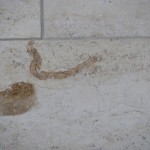 Are biological solutions an option?
Are biological solutions an option?
First and foremost, here is a little calculation for journalists and lawyers: if there are 381 ppm of CO2 in our atmosphere and the total amount of gas on this planet is 5,15 10^18 tons, then how many tons of CO2 are now in the atmosphere?
All joking aside, what I actually wanted to ask is: would this amount be enough to generate the Dolomite lime ledge anew?
For plants and organisms, CO2 is a phantastic raw material. In return for eating up C2, they set free the poisonous gas O2 in the atmosphere – which would otherwise only be there in minuscule amounts. Entire mountain ranges have to thank these digestive circles for their existence. It is always fascinating to hike to the Monte Baldo and notice remains of corals, sponges and snails.
CaMg(CO3)2 is the chemical formula for dolomite. You will find a nice overview under the header „Limestone“ in wikipedia. For the current discussion, it is important to note that there are processes for which CO2 is a raw material. These processes need CO2.
CCS is a denominator for the separation of carbon dioxide from the electric energy waste of power plants fed by fossil material. On the one hand, the separation lowers the efficiency factor of a power plant; on the other hand it provides a precious gas fraction. The RWE plan proposes a pressurized storage of gas on suitable sites in order to remove it from the atmospheric cycle.
Last year (2009) I witnesses enthusiastic debates in Bredstedt/Schleswig-Holstein. Plans to build a CO2 end storage in this area failed because of the political resistance among the population.
In times of world-wide CO2 trafficking, it can be quite profitable to pressurize CO2 underground. However, that is the one-sided, limited rationality and view of the machine engineer. As opposed to this, nature treats CO2 as a precious resource: sponges, coral polyps, radiolarian, foraminifers, snails,… these are all precious forms of life. So why not see the CO2 bond as an instigation to imitate the process in the sense of the bionical construction model in some way?
Then, CO2 is no longer a potential threat. Instead, it is a precious resource for feeding micro organical cultures, linking carbon hydrogen, or at least depositing it inertially in its stable phase as lime stone. Bredstedt would have one problem less to solve.
wl
(Translated by EG)
